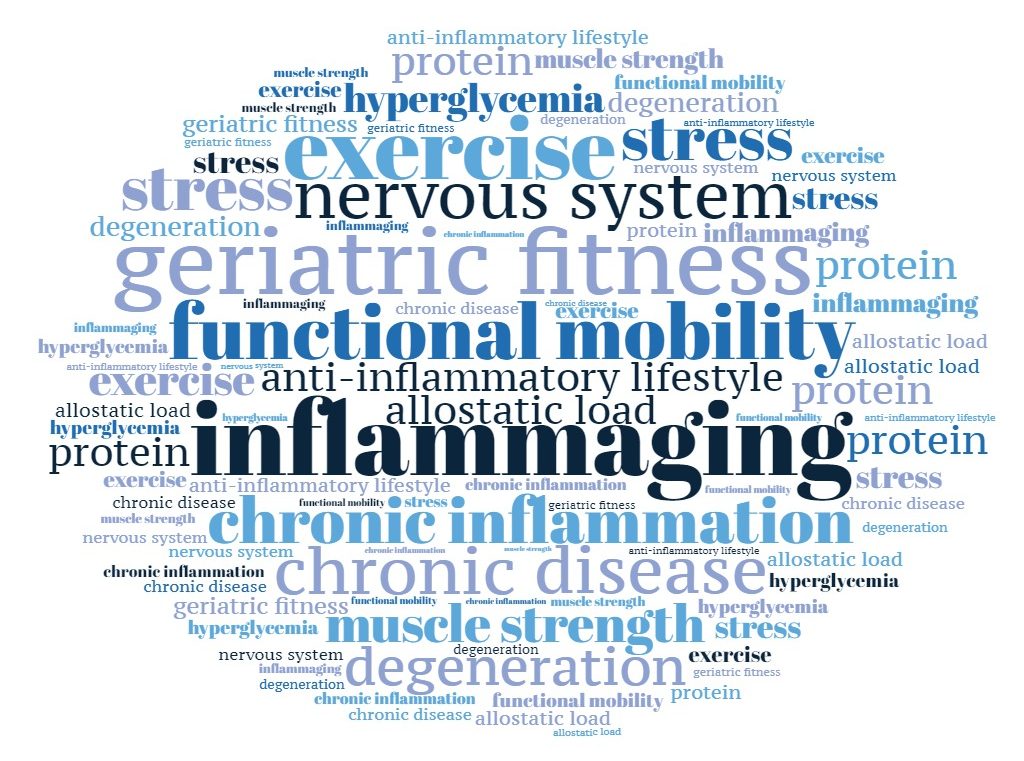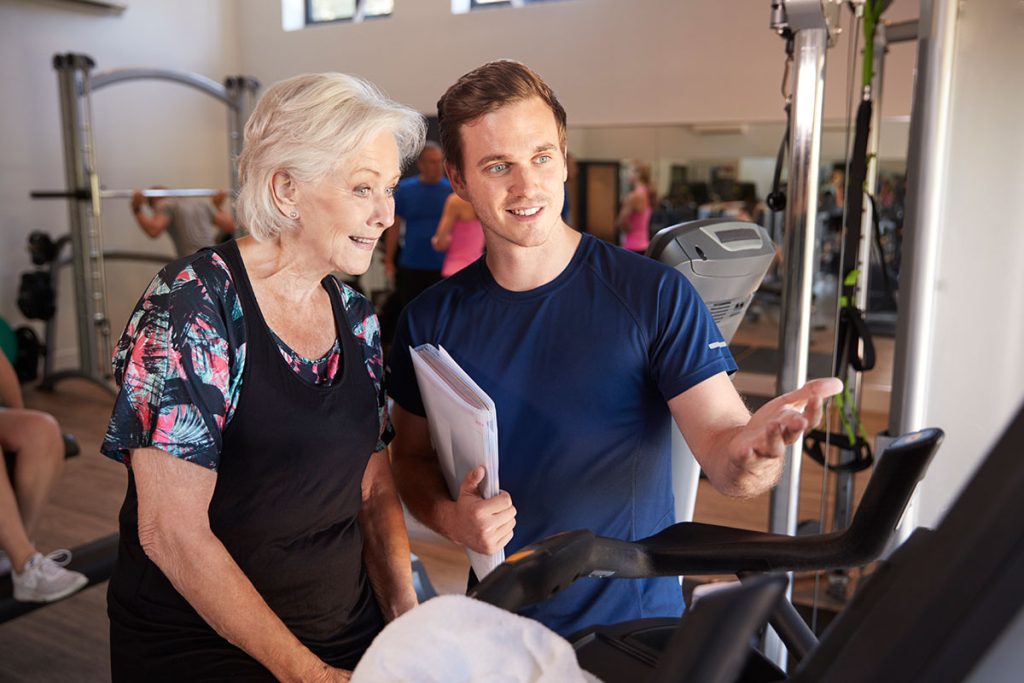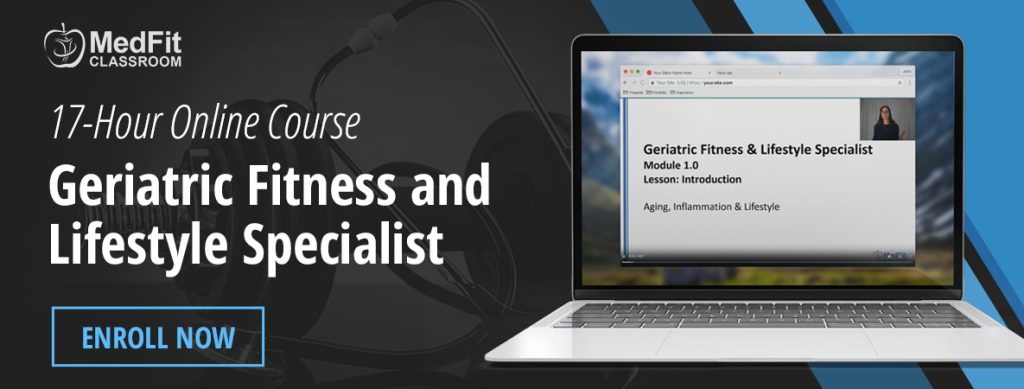
Awareness is the first step to making changes to live healthier, stronger, and longer. Older adults love to learn, and sharing life-saving information empowers them.
If you ask an older adult client, “What is inflammaging?”, they usually won’t know; yet inflammaging is a key concept to understand because it contributes to the decline of the body and brain, threatening functional independence, and increasing the risk of a devastating fall.
In 2000, Italian researcher Claudio Franceschi coined the term “inflammaging” to describe the chronic, low-grade, and systemic inflammation that accumulates over time and drives age-related diseases, disabilities, and mortality.
Acute inflammation is short-lived and is how the immune system heals and repairs the body from an infection or injury. When you sprain an ankle, the swelling that follows is a sign of the immune system working to heal the ligament damage. When you cut your finger or catch a cold, it’s your immune system that responds to mend that cut and fight off the viral infection. Acute inflammation is restorative.
When inflammation becomes chronic, the body’s cells, tissues, organs and systems begin to breakdown. Chronic inflammation is degenerative. Being systemic in nature, damage occurs throughout the body and brain. As the years and decades pass, the “wear and tear” accumulates and is known as the “allostatic load.” The higher the body’s burden, the greater the risk of dysregulation and malfunctioning of the body’s systems. This damage may go unnoticed until a clinical diagnosis of a chronic condition like diabetes, heart disease, cancer, dementia, or sarcopenia: the age-related loss of muscle mass, strength, and function.
Inflammaging is a constant stress on the body, causing it to break down more than it can repair.
This gradual chipping away at the muscular and nervous systems can literally shrink muscles and the brain. With progressive degeneration, clients may notice more fatigue, brain fog, fuzzy thinking, aches and pains, as well as feeling unsteady on their feet. This commonly leads to less activity, further accelerating the withering of both body and brain.
Muscles are the motors that move us, and as they atrophy it can become more difficult to walk, climb stairs, and perform activities like getting up from a chair. Crucially, muscles are also “glucose sponges.” When we lose muscle, blood sugar levels can spike higher, fueling more inflammation and degeneration. It’s estimated that with each decade, muscle declines by about 5%. At age 70, it jumps to a 15% decline. This is an example of muscle atrophy accelerating along with the accumulating damage or allostatic load.
The brain is particularly sensitive to hyperglycemia or high blood sugar. In fact, Alzheimer’s is often referred to as “Type III Diabetes.” This means muscle is an essential element for mental and physical health. Building muscle strength through resistance training is foundational to effectively extend one’s healthspan and age optimally.
The human body is incredibly resilient and can heal and repair itself at any age. Managing, slowing down, or even reversing muscular or neurological conditions begins with practicing an anti-inflammatory lifestyle. While there are many pillars of health, including stress resilience, quality sleep, nutrition, hydration, and social well-being among others, here are three top tips to empower, educate and encourage older adults to take action in reducing inflammaging for themselves.

1. Exercise Activity: Exercise reduces inflammation and maintains muscle; put simply, “move it or lose it.” Exercise with resistance using body weight, elastic resistance or weights, 2-3 times per week on non-consecutive days. Perform exercise with good body alignment across all three planes of motion to strengthen muscles and optimize functional mobility. Even performing light activity like housecleaning, cooking, or gardening can reduce the risk of mobility disability by 40%!
2. Protein Power: Older adults commonly do not eat enough, and it is vital to build muscle. Consuming protein at each meal also helps to regulate blood sugar levels. Research shows that a low protein diet can cause muscle atrophy. Try eating high quality protein with an average of about 30 grams of protein at each meal.
3. Breathe Deeply: Deep breathing activates the diaphragm, the main muscle of respiration. It delivers life-giving oxygen to every cell to produce energy. This can positively impact mental and physical health. Breathing deep into the belly, the front, back and sides can increase intraabdominal pressure for greater core stability and better balance.
While aging is inevitable, functional decline is not! Taking small but mindful steps towards reducing inflammation can be life-changing and life-saving. The best time to start is today!
Fit Pros: Guide Older Clients as a Geriatric Fitness and Lifestyle Specialist
Millions of people over age 65 looking for guidance from fitness professionals who are knowledgeable in exercise, nutrition and lifestyle principles that can help them improve functional mobility, while also preventing and managing chronic conditions to live their highest quality of life. The Geriatric Fitness and Lifestyle Specialist online certificate course will give you insights, strategies and tools to be a successful professional in this rapidly growing market. Learn how to be a valued part of clients’ continuum of care, working with the medical team to improve functional outcomes and positively impact people’s lives.

Cate Reade, MS, RD is a Registered Dietitian, Exercise Physiologist and Functional Medicine Practitioner candidate on a mission to improve functional mobility and health span utilizing the power of lifestyle medicine. She has been teaching, writing and prescribing healthy eating and exercise programs for over 25 years. Today, as CEO of Resistance Dynamics and inventor of the MoveMor™ Mobility Trainer, she develops exercise products and programs that target joint flexibility, strength and balance deficits to help older adults fall less and live more.
